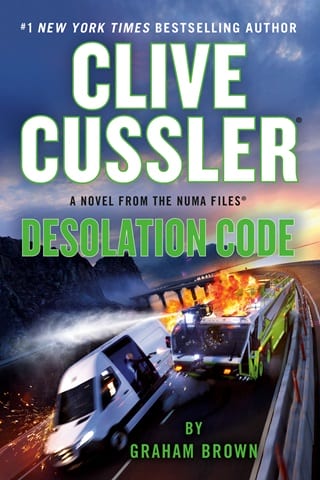Chapter 9
Digging his feet into the sand as he raced up the slope, Kurt kept his eyes locked on the departing figure. He wasn’t foolish enough to shout at the man and demand he stop, but the man picked up speed nearing the top of the beach and darted into the swirling crowd.
Kurt had to dodge and weave his way through onlookers, departing rioters, and arriving policemen. It slowed his progress, and by the time he crested the top of the beach and ran out onto the frontage road, he’d lost sight of the man in the swirling crowd. Kurt pushed past a second wave of policemen who were arriving on the scene and scanned the street.
He spotted the man beyond the row of emergency vehicles. He was heading toward a parked van. The side door flew open as he neared it and the laptop he’d taken was tossed inside.
Kurt raced for the van, but it pulled away as the man in black jumped inside.
Rushing up behind him, Joe had seen it all. “Now what?”
Kurt looked around. Their only option was the last vehicle in the crowd of emergency response units. A neon-green fire truck known as a Striker, which had come from the airport. Its distinctive shape, with an angular front end, extended cab, and six large wheels tucked under the body, suggested speed. Kurt hoped that looks didn’t deceive.
“Come on.”
He ran for the truck and found it empty and idling.
“This is a bad idea,” Joe suggested.
Kurt was already climbing into the driver’s seat. “Unless you have another one, this is all we’ve got.”
Joe jumped up onto the running board and climbed in, finding the passenger seat just as Kurt got the big truck moving. With the roar of seven hundred horsepower, the heavy machine lumbered ahead.
Up ahead, the van had come to a traffic light, where it was blocked by a few cars. It slowed and stopped as if pretending to be just part of the regular traffic. It was a fair ruse, but whatever nerve the driver had failed before the light changed. The van lurched forward and pulled onto the sidewalk, clipping a car in front of it and taking out several garbage cans before racing down the path, scattering pedestrians like they were pigeons in the town square.
Kurt kept the Striker rolling, leaning on the horn repeatedly as they approached the light. Joe found the switch for the overhead emergency lights and flipped it. The flashing beacons and the ear-shattering blasts of the horn, accompanied by the sight of the neon vehicle coming down the road, were enough to make the cars pull quickly out of the way.
As the sea of cars parted, Joe offered a repentant shrug. “Maybe the fire truck wasn’t such a bad idea after all.”
Kurt grinned, working the steering wheel and the pedals, trying to get used to handling the big machine without playing bumper pool with the other cars around them. He’d driven plenty of trucks in his time, but the Striker maneuvered differently. Despite the weight, it was easy to turn, but sitting so far forward made it feel like every lane change or course adjustment was a wild overcorrection.
The van had come down off the sidewalk and hurtled toward the next intersection. Its brake lights lit up as it raced around the turn, headed for what looked like an elevated highway.
Kurt approached the turn, hitting the brakes late and finding they had little effect on the heavy truck’s built-up momentum. He began to cut the wheel to the right, but a shout from Joe changed his mind.
“Light post,” Joe called out. “Take it wide!”
Kurt swung the wheel to the left, hand over hand, and then spun it back to the right. Because of how far the wheels could deflect, the big rig made the turn, swinging out and then back, narrowly missing the light post with its tail end.
They rumbled down the next street, the height of the cab allowing them to keep their eyes on the van. From the left lane, it cut across the oncoming traffic and onto a ramp, accelerating up the slope at maximum speed.
A sign beside the ramp read NR-1 .
“He’s heading for the coastal road,” Joe said.
Kurt changed lanes a little awkwardly, leaned on the horn again, and directed the Striker onto the ramp. Once they were pointing down the center of the lane, he floored the pedal once again. The engine roared with deafening power. Kurt heard Joe shouting something, but it was little more than static behind a wall of noise.
He kept his eyes focused forward as Joe clamped a pair of noise-canceling headphones over his ears. He turned to see Joe wearing a set as well. They were hooked to the intercom system with audio jacks.
“Breaker, breaker, good buddy,” Joe said.
Kurt laughed. They were thundering down the highway in a ten-ton truck. If there was ever a time to act like they were in a Smokey and the Bandit movie, this was it.
They topped the ramp and raced onto NR-1, the island’s main highway, a multilane road that ran along the shore at the bottom of steep volcanic cliffs. On a normal weekday, eighty thousand cars would use this road, but it was Saturday afternoon, and the traffic was light.
Ahead of them the van sped up rapidly, quickly passing the 110-kilometer-per-hour limit. It took the Striker a full minute to match the pace, and by that time the van was a thousand yards ahead of them.
“Keep an eye on him!” Kurt shouted, picking a line between the cars that were trying to get out of his way.
“What do you plan to do if we catch them?”
“A slight nudge should push them off course,” Kurt said.
“Or,” Joe suggested, “we could call for assistance?” He pointed at the radio.
“While it goes against everything I believe in,” Kurt joked, “it’s probably the best idea.”
As Kurt moved into the outside lane, Joe got on the radio and attempted to call for help. An angry voice answered in French, speaking so rapidly neither Kurt nor Joe could make out what was being said.
“Pretty sure I heard something about a stolen truck,” Kurt said.
Joe tried to explain in rudimentary French that they were chasing a fleeing vehicle. He mentioned the prefect and the fire chief and NUMA. Releasing the talk switch, he got another tongue-lashing, and then nothing but silence. Not even static. “That’s weird.”
Joe flipped the power switch off and on, and then tried again. “We’ve been cut off.”
“Try your phone.”
Giving up on the radio, Joe pulled out his phone and dialed the Reunion emergency number, which was 112. As an operator came on, he began to explain the situation, but in less than ten seconds the call dropped. Try as he might, Joe couldn’t get it back. He looked at his phone: “No signal.”
That was odd, Kurt thought. Especially as they were racing along the main highway and there were cell towers every couple of miles.
“Back to plan A,” Kurt said, focused on driving. “We catch them, give them a little nudge, and wait for the insurance investigator to come along and tally up the costs.”
At full speed and on a slight downhill grade, they were now closing in on the van.
“Curve coming up,” Joe noted.
A long, wide bend around a point on the island’s coastline loomed. A car would take it with ease, the van might lean a little, but the fire truck filled with thousands of pounds of liquid might barrel off road and onto the rocks below. Kurt swung as wide as he could, pressing the brakes and hoping for the best. “Hang on!”
Kurt aimed for the apex of the turn, which would limit the side load. He and Joe both leaned over, as if it would help.
The Striker cut the corner crossing from the outside lane, down to the shoulder, and back to the far lane. The wheels chattered rather than slid, but there was so much rubber on the road that the real danger was flipping. At the very edge of its limit the Striker kissed the divider just hard enough to reroute the truck back onto the straight if not narrow.
The entire turn cost them less speed than Kurt could have possibly expected. But the grade was now slightly uphill, and the van was pulling away.
“We’re too heavy,” Kurt said.
“I’ve got an idea,” Joe replied.
One at a time he opened a trio of valves, activating a set of high-flow, wide-angle spigots that were arranged underneath the body of the Striker. The large, downward-pointing nozzles were unique to airport firefighting trucks. They were designed to flood the tarmac and allow the truck to race across swaths of burning jet fuel by dousing the fires and diluting and spreading out the remaining fuel.
An additional nozzle on the upper part of the truck was designed to launch a curtain of water at the side of a downed aircraft, creating a path for crash survivors to escape into. Joe activated that as well.
The Striker roared up the highway, blasting water in all directions. Cars behind them slowed. Tourists and locals took pictures with their phones as the strange sight raced by.
It didn’t take long for Kurt to feel the difference in handling. The tanks in the back end of the truck held three thousand gallons of water, which weighed nearly eighteen hundred pounds. In sixty seconds half of that was gone. Thirty seconds later some type of auto shutoff began blinking yellow and the waterworks ceased.
By now the Striker was handling like a sports car. It closed in on the van, its greater power and suddenly lighter weight giving it a better top speed than the delivery van’s small four-cylinder engine.
Kurt swung to the outside lane, moving the nose of the Striker ahead of the van’s bumper. Before he could sideswipe it, the side door opened and the man in black appeared with a weapon in his hand.
Kurt turned hard toward the van, hoping to hit it before the gunman could fire, but the weapon flashed, and a spread of bullets hit the Striker’s glazed and tinted windshield. Several holes appeared, with cracks radiating outward, but the windshield held.
Joe put his finger in one of the holes, tracking the path of the bullet through the windshield and then up and out through the roof. “Shatterproof, not bulletproof,” he said. “Probably made from two layers of tempered glass sandwiched around a thin Kevlar film. It won’t cave in on us, but it’s not going to deflect a well-aimed shot.”
Kurt had dropped in behind the van, trying to stay away from the open door. As the path straightened out, they went downhill once more, this time onto what was called the New Coastal Road. This new stretch of elevated highway was an ostentatious and ambitious project that moved the multilane road away from the steep volcanic slopes and out onto the water.
Instead of hugging the base of the volcanic mountains and zigging in and out with every curve of the coastline, the New Coastal Road sat a hundred feet offshore, six lanes of glorious new concrete and macadam running on viaducts held up by massive pylons that rose a hundred and twenty feet above the water.
The New Coastal Road had been called the most expensive road in the world, costing over two billion dollars for seven miles of elevated highway. It offered spectacular views of the ocean on one side and the mountains on the other. Looking down, one could see the waves rolling beneath it and crashing against the black sand beaches.
Invigorated by the change of scenery and encouraged by the flat, smooth blacktop, Kurt hammered the accelerator once more. Here the Striker would have the advantage, and Kurt needed to make the most of it before the tighter curves came into play once again.
“Deploy the boom!” he cried out. “Prepare for ramming.”
 Fullepub
Fullepub 



